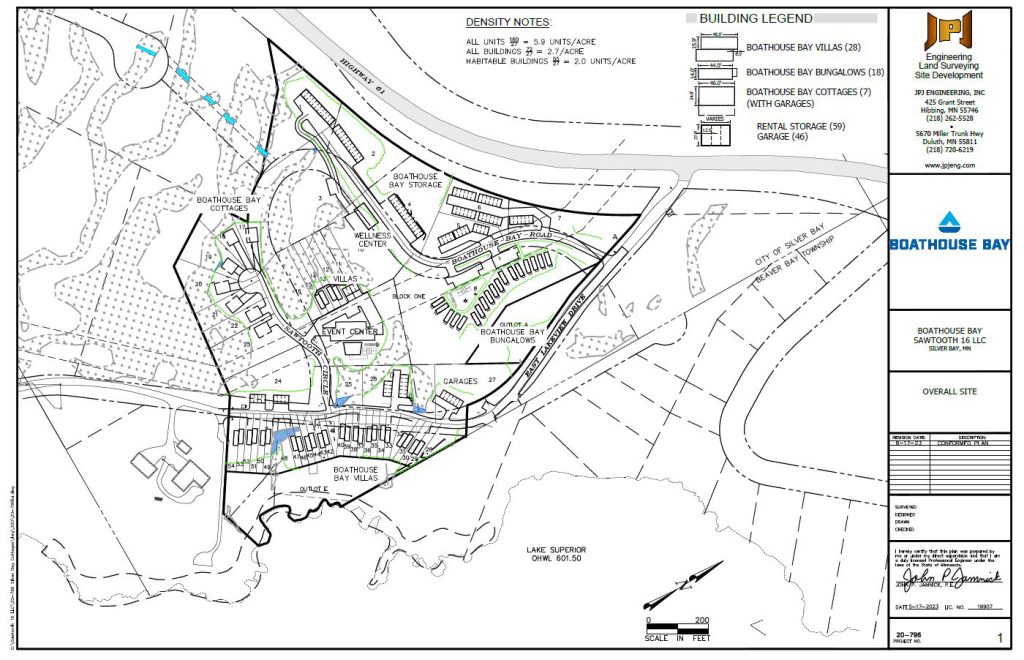In the bright sunshine of a late January day, a contingent of state and local dignitaries joined developer John Anderson for the ceremonial groundbreaking of the Boathouse Bay project in Bayview Park on the lake side of Highway 61 in Silver Bay. According to David Drown, the city’s economic development director, work will be underway this spring to complete the utility infrastructure and begin construction of the housing units planned by Anderson.
Silver Bay officials and planners realized its existing infrastructure, installed in the 1950s, will need repair and replacement. An expansion of its tax base is required to pay for that, and Boathouse Bay delivers that expansion.
Described as a “recreational residential development” on the Boathouse Bay website, the 24 high-end villas and 18 bungalows are the first part of a five-year, planned development project, including an event center, seven residential lots, and a 110-unit mini-storage complex that will fill the space between the residential sites and Highway 61.
Anderson purchased the original two-acre site, which included an old boathouse on the shore, thus the name, almost 20 years ago. “It was the coolest piece of property I’d ever seen,” he said. As he and a partner planned to develop it, the great recession of 2008 caused them to pull back.
To help achieve the Boathouse Bay vision, Silver Bay sold Anderson the 24 acres adjacent to his property for $1 under the condition that the project be completed in five years.
With 600 feet of Lake Superior shoreline, Boathouse Bay is bordered on both sides by a combined 4,000 feet of shoreline controlled by the city. The city shoreline includes Black Beach, a public access beach built with tailings from the taconite mill. It is a popular stop for visitors and locals.

The development, planned by Anderson and Drown, along with other city officials over the last few years, is projected to cost up to $25 million. It is the most significant single development in Silver Bay since Reserve Mining built the city in the 1950s to provide housing, recreation, and education for workers at its taconite processing plant and railroad.
Anderson is the classic property developer. He can see the project finished in his mind’s eye. “This is a big, big thing,” he said. Anderson indicates Boathouse Bay may be his last development project. “When this is done, the kids are going to take the car keys away from me,” he said with a chuckle.
The project is divided into three phases. It starts this year with building six villas and completing the mini-storage buildings. The mini-storage contains 110 units and will serve as a buffer between Highway 61 and the residential properties.
Anderson intends to complete the project within five years, and Drown expects the city’s infrastructure debt to be paid in full within eight years.
Additional phases will see the construction of seven single-family homes, the remaining villas, 18 bungalows, and a moderate-sized event/meeting center.
In addition to diversifying the local economy and taking advantage of the booming tourism opportunities the North Shore provides, city leaders look to attract new residents, create jobs, and provide additional housing options for people living and working in the area.
Drown said, “The concepts presented in the Master Plan we’ve developed have been in the minds of people here for a long time.”
In addition to Boathouse Bay, the city’s future development vision includes a Fishing Village with restaurants and retail offerings in Bayview Park. Silver Bay also plans a 40-lot housing subdivision surrounding its public golf course in the northwest of the city to add housing and expand its tax base.
Silver Bay created an industrial business park over 20 years ago, now called Bayview Park. Like all North Shore communities, it had difficulty attracting industrial businesses. The city council rezoned the business park, changing its name from Silver Bay Business Park to Bayview Park last December. The new zoning enables residential and mixed-use commercial development and facilitated negotiations with Anderson to develop Boathouse Bay.
Drown is the founder and president of David Drown Associates, Inc., based in the Twin Cities. On its website, Drown writes, “I founded DDA back in 1997 with one thing in mind—providing rural Minnesota government with straightforward, common sense financial help.”
Long-time visitors to the North Shore, Drown and his wife found a piece of land just north of Silver Bay and built the log home where they spend most of their time. He is semi-retired from his business.
Drown began working with the Silver Bay EDA about three years ago. “I now work about 30-40 hours weekly for Silver Bay,” he said. The energetic Drown brings years of experience in public finance and development to the job pro bono, which brings significant value and savings for Silver Bay taxpayers.
A homeowners’ association will govern the development, and Anderson’s management company will oversee the properties.
The Minnesota Department of Iron Range Resources & Rehabilitation (IRRR) supported the Boathouse Bay project with over $1.4 million in Development and Community Infrastructure grants to the City of Silver Bay. The funds help pay for the water and sewer, roads, and engineering related to the infrastructure needed to support the development.
In the February 7 issue of The Ranger, the online newsletter of IRRR, Commissioner Ida Rukavina said, “One of the areas that our agency is committed to is housing, which is a large factor when measuring a region’s economy and quality of life. The supply and choice of housing inventory in northeastern Minnesota is low, and the demand is high. The need for additional and more choices of housing impacts employers, employees, communities, and new and existing residents. Boathouse Bay will help increase the housing capacity in our region, and we support Silver Bay in their plans to grow their community.”

